March 3, 2015

When Healthcare is a “Lemon”: Asymmetric Information and Market Failure
In 1970, George Akerlof published “The Market for “Lemons”: Quality Uncertainty and the Market Mechanism” in The Quarterly Journal of Economics. Highlighting used-car sales, Akerlof explored why market failure occurs when used-car sellers have more information than used-car buyers. His article expanded market analysis beyond “perfect competition” to include powerful exogenous variables and won him the 2001 Nobel Prize in Economic Sciences.
Preventable bad outcomes and opaque pricing are healthcare’s “lemons”. Asymmetric information exchange between providers and patients contributes to medical errors, customer frustration, over-treatment and under-treatment in U.S. healthcare. Equalizing information exchange engages patients, improves outcomes and reduces unnecessary healthcare expenditure.
How “Inside Information” Distorts the Used Car Market
Akerlof observed large price differentials between new and used cars and explored why they occurred. With new cars, neither the buyer nor the seller knows whether the vehicle is a good car or a “lemon”. That reality emerges over time. When selling the car, the owner knows whether it is a good car or a lemon. A prospective buyer knows only that some cars are good and some are lemons. This creates an asymmetric information relationship between the car’s seller and prospective buyers. In essence, the seller has “inside information” that distorts the negotiating process.
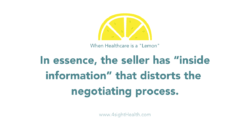
A lemon is worthless, and half the time the car is a lemon. Here’s what happens when a good car is worth $10,000:
- The expected value of the car is $5,000 (50% times $10,000)
- The owner of a good car requires $10,000 to sell the car
- No mechanism exists for a good car’s owner to demonstrate its worth
- The lemon’s owner would gladly take $5,000 for the car
- A buyer will never pay more than $5,000 (and probably less) given the fifty percent probability of purchasing a lemon
- This information asymmetry prevents owners of good cars from finding buyers willing to purchase the car for its $10,000 value, so they don’t sell their cars
- As good cars leave the market, only lemons remain available for purchase
Market failure occurs as “bad cars drive out the good because they sell at the same price as good cars…the bad cars sell at the same price as good cars since it is impossible for a buyer to tell the difference between a good and a bad car; only the seller knows.” Inside information compromises the symmetry required for proper market functioning. Sellers become predatory. Buyers become defensive. Potential transactions dissolve.

Given these dynamics, it’s not surprising that “used car salesmen” have achieved iconic status as unscrupulous, fast-talking charlatans. As Akerlof observes, “dishonest dealings tend to drive honest dealings out of the marketplace.”
Asymmetric Information and Healthcare Outcomes
Akerlof’s “lemon” theory applies in all markets where asymmetric information exchange exists between buyers and sellers. A sick individual’s superior knowledge of their medical needs gives them an asymmetric information advantage in purchasing health insurance. Sicker consumers are willing to pay higher prices for medical insurance based on higher anticipated medical costs.
In response, private health insurers screen customers to eliminate high medical users (i.e. to avoid “adverse selection”), establish coverage limits and increase premiums to cover perceived financial risk. Higher premiums distort the health insurance market for healthy consumers and many exit. In these ways, information asymmetry contributes to the U.S. health system’s high absolute costs, high administrative costs, its large uninsured population and the inability of many Americans to afford needed care.

Less documented is the impact information asymmetry has on healthcare delivery once patients enter the system. Information asymmetry helps cause “lemon-like” outcomes in the following three ways:
- Doctors and other caregivers overwhelm patients with information and deliver treatments that often are unnecessary;
- Doctors and other caregivers do not engage patients sufficiently and fail to provide necessary care; and
- Uniformed patients demand unnecessary treatments (often based on anecdotal experience, social media conversations or faulty research).
In the same way that used-car buyers question a seller’s motivation, Americans increasingly question whether providers act in patients’ best interests. They turn first to the internet, not doctors, with medical questions. They are exhibiting higher levels of innate distrust toward providers.
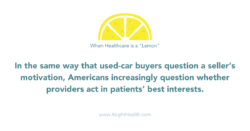
Negative media coverage, like Time Magazine’s “Bitter Pill” cover story, fuels consumer distrust. As health companies adapt to health reform in a cloud-based world, they must find ways to build customer trust/loyalty and signal their alignment with patients.
Overcoming Information Asymmetry
In To Sell is Human, author Daniel Pink describes a “seller-beware” marketplace where buyers have access to all information they require to purchase goods and services. Today’s buyers are less susceptible to the problems of information asymmetry Akerlof describes.
Pink envisions emerging “information parity” where buyers and sellers work together to solve buyers’ problems. In Pink’s world, honesty, fairness and transparency govern the buy-sell relationship. This certainly applies to used-car sales.
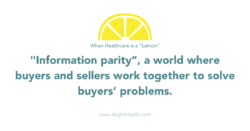
Buyers have new tools (e.g. Carfax; internet pricing comparisons; vehicle-specific social media sites; etc.) to assess the price and reliability of used cars. Sellers offer warranties, brand strength and tailored servicing to signal their willingness to provide a good car at a good price. Sellers and buyers work together to find the right car for the buyer.
Health companies can and should employ the same consumer- friendly strategies (e.g. price and outcomes transparency) to engage customers and signal their intentions to provide the right care at the right price at the right time in the right place. This means aligning health company intentions and actions with patient interests – not easy but necessary.
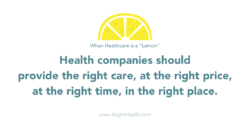
Under Joe Fifer’s leadership, the Healthcare Financial Management Academy (“HFMA”) has made pricing transparency a major initiative. Before becoming HFMA’s CEO in June 2012, Fifer championed price transparency at Spectrum Health in Grand Rapids, Michigan. Spectrum publishes average prices by payor for its surgical, medical and diagnostic procedures. Fifer believes full pricing transparency not only leads to better medical decision-making; it also informs the public debate regarding subsidies for lower-paying patients and community benefit programs.
Hospitals and doctors that fail to follow Spectrum’s excellent example on pricing transparency will be over-run by market-based initiatives to inform consumers regarding procedure pricing. From Castlight to MD Insider, private companies are betting their futures on providing accurate and comparable pricing data to consumers and their employers.
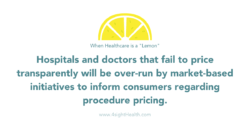
Aetna, Humana, United HealthCare and the Health Care Cost Initiative (“HCCI”) have launched Guroo, a transparency website that provides pricing information on seventy services in over three hundred cities in fortyone states and the District of Columbia. Quality metrics are soon to follow. Expect this transparency wave to increase as bundled payments for specific procedures become commonplace.
Decision Aids Facilitate Shared Decision-Making
Group Health’s use of decision aids illustrates the power of “seller-beware” behavior. In the September 2012 issue of Health Affairs, Group Health physicians published the results of an observational study for 9,515 knee and hip replacement candidates. They engaged patients in shared decision-making on replacement surgeries with and without video decision aids (researched-based video decision tools developed by Health Dialog that clearly explain a patient’s treatment choices).
Informed patients, on average, chose less intensive therapies and incurred lower care costs: 26% fewer hip replacements; 38% fewer knee replacements and 12%-21% lower costs. By working with patients to determine their best care program, Group Health engaged patients and achieved better outcomes at lower costs.
Information asymmetry remains a fundamental challenge for most health companies; yet, there is nothing more important than engaging customers in their medical decision-making. It’s not only the right strategy for patients. It’s smart business strategy.
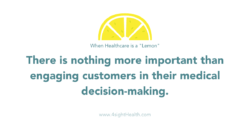
If you enjoyed reading this article, please share with a friend. For more information, please checkout our insights page here. You can also join 5k+ revolutionary healthcare leaders who read 4sight Friday for weekly healthcare opinions, insights and news here.





